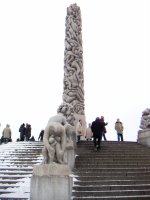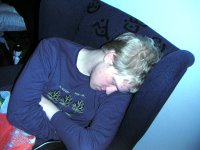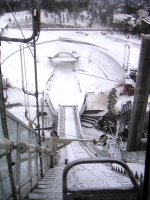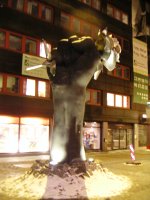Batman Begins
It's been 8 years since Batman & Robin (which I haven't seen). The franchise was pretty much dead in the water, but then rumors began circulating. Then it was announced that Chris Nolan was to direct. Coming off the back of the superb Memento and the Insomnia remake, he was a director on a roll. Here he has produced a gritty realistic Gotham. Rather than just give us a ready-made Batman as Tim Burton did, Nolan gives us a background to Bruce Wayne. Before we can get into Batman, Nolan feeds us what drives Bruce - we have to wait an hour Before see Batman. As with the best films, the build up works perfectly: never do we feel impatient to see the batsuit, we are totally caught up in Wayne's inner turmoil as he struggles to deal with his guilt. The story goes back and scrubs out the previous films history. As with the comics, it isn't Jack Napier/The Joker that kills Bruce's parents. The main villains; the Scarecrow and Ra's Al Ghul aren't amongst the most well-known, but it means that they don't overshadow the film.
Sin City
Another comic book adaptation. This time taking 4 of Frank Miller's Sin City tales and moving them nearly frame for frame onto the big screen. Initially wary of Hollywood, Miller was convinced to accept Robert Rodriguez offer after the director produced what is now the opening scene from the film with Josh Hartnet. Shot entirely in front of a green screen, all the environments, including the rain, was added afterwards. This allowed the film to follow the comic by literally copying scenes from the graphic novels. The film itself is not for the faint-hearted. After the recent "watered-down" films such as Terminator 3 and Aliens Vs Predator its a relief that Sin City is a mind-numbing meld of violence, swearing and blatant sexism. It works, because despite everything, you just can't look away - you eyes are drawn to the sight of Bruce Willis beating Nick Stahl's head until its nothing but yellow pulp, Marv de-limbing creepy former hobbit Elijah Wood, or assassin Miho decapitating corrupt police officers and Irish mercenaries left right and center. The thing is just soooooo stylish! Despite all the violence and apparent misogynism, all the leads are trying to do the right thing in their own minds - Marv trying to avenge the girl of his dreams, Dwight trying to protect the girls of Old Town and Hartigan striving to keep his promise to protect Nancy. The good news is e sequel will be with us soon.
Sideways
Now here's a weird film. A gentle comedy about mid-life crisis and wine-tasting. The trouble with billing a film as a comedy these days is that everyone expects the next American Pie with laughs every second. The comedy is almost a by-product of the complete mismatch of characters that Miles and Jack. Linked by the fact that they were room-mates at college, there is no way they should ever have been friends. Yet here they are celebrating Jack's last week of freedom before he gets married. Miles has a relaxing bonding week in mind, but Jack has something else in mind. Miles' past catches up with him - his book is rejected, he discovers his ex-wife has remarried, he has to keep Jack out of as much trouble as he can - involving aggressive golfers, lamas, waitresses and even an enraged naked man. Miles has his chance at happiness it relies on keeping Jack's secret. At the end of the film, we are left on the verge of his redemption. Director Alexander Payne has suggested that he doesn't find it, but the big step for Miles is that he takes the chance and tries. Oh - and don't order Merlot.
The Life Aquatic with Steve Zissou
The latest film from quirkmaster himself, Wes Anderson. Again, he stays with Bill Murray who is enjoying a renaissance. The film remains dead-pan at all times but brings out all sorts of laughs; from the bizarre merchandising (the Zissou Adidas trainers occasionally pop up on eBay but are fakes) to the almost slapstick sight gags such as Hennessy's boat incident and complete contempt shown towards the interns. The film turns to the surreal with the Spanish versions of Bowie songs, the bizarre creatures and the shootouts with the pirates. As with his earlier films, Anderson can move us to tears as well. The appearance of the shark to a Sigur Ros track and the burial at the sea and the final triumphant march, all strike a chord. A lot of people don't get Anderson and his quirky films and indeed they may need a second watch, but don't let that put you off.
Wallace and Gromit and the Curse of the Were Rabbit
his one only just made the list as I only saw it last week. Initially I was doubtful this would be good - surely, Nick Park couldn't extend the winning Wallace and Gromit formula to an entire film; surely Hollywood would interfere and remove the unique "Britishness" of it. Thankfully it turned out wonderfully. The Americans may have their own version but ours is so proud of its English heritage that it can't help but make you smile. As for the film, Aardman have manage to create a film that charms and entertains so much. The running time means that there is plenty of time for the characters to develop and yet the film never feels overlong and all the jokes hit home perfectly, from the classic Wallace and Gromit fodder such as the wacky machines that inevitably go wrong to moments like Gromit and Philip struggling to find change so they can continue their chase to the cheese humor, this film has been so lovingly made. This is everything Chicken Run should have been. The only down-side is the long wait we'll have to endure until the next film.
So there you have it - what I thought were the best films that I saw last year. There are good films coming up. I've got Grave of the Fireflies to watch which I'm apprehensive about watching - simply reading the user reviews on imdb chokes me up so I dread to think what the film itself will do. This powerful antiwar film is screened every year in Japan on the anniversary of the dropping of Little Boy on Hiroshima. Unfortunately, since it's animated, many people will pass this off as a childrens film, which it certainly isn't. Next up is Ghost in the Shell: Innocence, the trailer for which looks amazing...
Oh - and Happy New Year













































